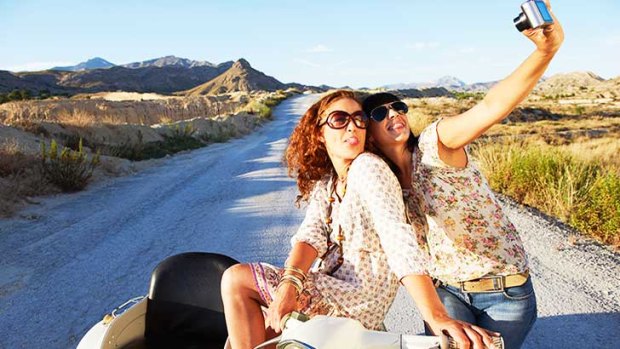By Tatyana Leonov

The art of a selfie: be ready to snap away at a moment's notice.Credit: Getty Images
The term selfie was coined in 2005 as a way to describe a special kind of self-portrait.
It gained cult status thanks to MySpace between 2006 and 2009, but back then was referred to as a MySpace pic.
In 2009 Facebook overtook MySpace in traffic numbers, and with the Facebook phenomena this amateur self-portrait type of photo was further propelled into the public arena.
It wasn’t just kids doing it anymore, parents were getting in on it too, even grandparents started taking selfies.
To cater to the frenzied self-photo taking audience Apple released the iPhone 4 with a front-facing camera in 2010, then along came Instagram in 2011… and by 2013 the word selfie was named as the word of the year by the Oxford Dictionaries, which define it as a photograph that one has taken of oneself, typically one taken with a smartphone or webcam and uploaded to a social media website.
Today a selfie is as everyday as breakfast to some people, and here is all the info you need to jump on the “I can take a good travel selfie” bandwagon.
Be ready at all times
The best selfies are the ones that are hard to capture so it’s vital to be ready to snap away at a moments notice, especially while travelling. Wild animals in Africa won’t wait for you to get your setup ready – they’ll either run away, or perhaps towards you… neither of which is ideal. When it comes to popular attractions it could be about snapping a photo of yourself with no other people in the background – again something you need to be ready for quickly when the opportunity arises.
Frame the setting
With travel selfies it’s assumed the background is pretty important. Whether it’s the stately Colosseum, the sprawling expanse of Machu Picchu or the iconic Eiffel Tower, you need to offset your face and make room for the scenery. Yes, the shorter your arm is the harder this might be, but there are ways to work around this. Changing the angle of a shot can make for extra background space, and technically even setting the timer and then running into the photo is still classed as a selfie according to some people.
Settings
Camera phones have come a long way in the last few years, but they still vary greatly from phone to phone. Your phone evidently needs to have photo-taking facilities, and the higher resolution back-facing camera is generally the best way to go. Learn when to use (and not to use) flashes for the best effect, and if in doubt snap two versions of the same selfie (one with the flash and one without). There are also a huge variety of apps out there that allow you to tweak different elements of the shot to create a better end product.
Filters and more advanced photo editing
Filters were created to enhance photos, and the effect is often major and can change a poor photo in to something your followers will talk about for ages. Don’t go overboard, but use the nifty function when needed. Some Instagrammers exaggerate the filter effect but have thousands of followers because of how they do it. For example, when travelling natural landscapes can look even more amazing with the right filter. Others are known for never using a filter. Choose a style and make it your own.
Poise and pose
The two Ps are very important. Get one of these wrong and you’ve got yourself a selfie failure. Odd angles can create accentuated noses and foreheads, neither of which generally classify as attractive. Also, what you may not instantly realise, is that although you’re taking the photo on your smart phone and it looks good, someone else might be seeing it on the iPad – in which case it comes up much bigger.
Get creative
Selfies don’t just have to be about one expression (duckface was never cool), but they don’t just have to be of your face front on. Feet, arms, fingers and other body parts, styled in an interesting way, can often make for (arguably) more thoughtful shots, especially in hard-to-get-to locations that you can brag about down the track. Think outside the square. Sure, hands holding up the Leaning Tower of Pisa make for your standard selfie shot, but what if you used your feet instead to make it a little different.
How many
Taking too many selfies isn’t a massive problem as long as they stay on your phone. Knowing how many to post on social media sites is a whole other topic. Numerous studies suggest that most people do not perceive too many shared selfies as positive. It’s important to err on the side of caution when deciding whether or not your friends and followers really want to see another photo of you that hour/day. One shot of yourself in a stunning location per day is probably OK, but when you start hitting plural numbers it really depends on who your followers are and what kind of content they like.
Sign up for the Traveller Deals newsletter
Get exclusive travel deals delivered straight to your inbox. Sign up now.